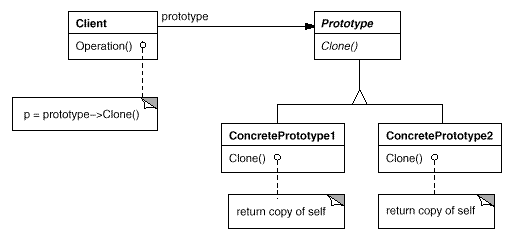模式設計 建立型 Prototype
| 名稱 | Prototype |
| 結構 |  |
| 意圖 | 用原型例項指定建立物件的種類,並且通過拷貝這些原型建立新的物件。 |
| 適用性 |
|
Code Example
 namespace Prototype_DesignPattern
namespace Prototype_DesignPattern {
{ using System;
using System;
 // Objects which are to work as prototypes must be based on classes which
// Objects which are to work as prototypes must be based on classes which 
 abstract class AbstractPrototype
abstract class AbstractPrototype  {
{ abstract public AbstractPrototype CloneYourself();
abstract public AbstractPrototype CloneYourself(); }
}
 // This is a sample object
// This is a sample object class MyPrototype : AbstractPrototype
class MyPrototype : AbstractPrototype  {
{ override public AbstractPrototype CloneYourself()
override public AbstractPrototype CloneYourself() {
{ return
return }
} // lots of other functions go here!
// lots of other functions go here! }
}
 // This is the client piece of code which instantiate objects
// This is the client piece of code which instantiate objects // based on a prototype.
// based on a prototype.  class Demo
class Demo  {
{ private AbstractPrototype internalPrototype;
private AbstractPrototype internalPrototype;
 public void SetPrototype(AbstractPrototype thePrototype)
public void SetPrototype(AbstractPrototype thePrototype)
 internalPrototype = thePrototype;
internalPrototype = thePrototype;  }
}
 public void SomeImportantOperation()
public void SomeImportantOperation() {
{ // During Some important operation, imagine we need
// During Some important operation, imagine we need // to instantiate an object - but we do not know which. We use
// to instantiate an object - but we do not know which. We use // the predefined prototype object, and ask it to clone itself.
// the predefined prototype object, and ask it to clone itself. 
 AbstractPrototype x;
AbstractPrototype x; x = internalPrototype.CloneYourself();
x = internalPrototype.CloneYourself(); // now we have two instances of the class which as as a prototype
// now we have two instances of the class which as as a prototype }
} }
}
 ///<summary>
///<summary> /// Summary description for Client.
/// Summary description for Client. ///</summary>
///</summary> public class Client
public class Client {
{ public static int Main(string[] args)
public static int Main(string[] args) {
{  Demo demo = new Demo();
Demo demo = new Demo(); MyPrototype clientPrototype = new MyPrototype();
MyPrototype clientPrototype = new MyPrototype(); demo.SetPrototype(clientPrototype);
demo.SetPrototype(clientPrototype); demo.SomeImportantOperation();
demo.SomeImportantOperation();
 return 0;
return 0; }
} }
} }
}
C#對原型模式的支援
在C#裡面,我們可以很容易的通過Clone()方法實現原型模式。任何類,只要想支援克隆,必須實現C#中的ICloneable介面。ICloneable介面中有一Clone方法,可以在類中複寫實現自定義的克隆方法。克隆的實現方法有兩種:淺拷貝(shallow copy)與深拷貝(deep copy)。
五、 淺拷貝與深拷貝
下面給出淺拷貝與深拷貝的兩個例子,例子使用了ICloneable介面。C#中的陣列是引用型的變數,我們通過陣列來進行演示:
淺拷貝:
 using System;
using System;
 class ShallowCopy : ICloneable
class ShallowCopy : ICloneable {
{ public int[] v = {1,2,3};
public int[] v = {1,2,3};
 public Object Clone()
public Object Clone() {
{ return this.MemberwiseClone();
return this.MemberwiseClone(); }
}
 public void Display()
public void Display() {
{ foreach(int i in v)
foreach(int i in v) Console.Write( i + ", ");
Console.Write( i + ", "); Console.WriteLine();
Console.WriteLine(); }
} }
}
 class Client
class Client {
{ public static void Main()
public static void Main() {
{ ShallowCopy sc1 = new ShallowCopy();
ShallowCopy sc1 = new ShallowCopy(); ShallowCopy sc2 = (ShallowCopy)sc1.Clone();
ShallowCopy sc2 = (ShallowCopy)sc1.Clone(); sc1.v[0] = 9;
sc1.v[0] = 9;
 sc1.Display();
sc1.Display(); sc2.Display();
sc2.Display(); }
} }
}
ShallowCopy物件實現了一個淺拷貝,因此當對sc1進行克隆時,其欄位v並沒有克隆,這導致sc1與sc2的欄位v都指向了同一個v,因此,當修改了sc1的v[0]後,sc2的v[0]也發生了變化。
深拷貝:
 using System;
using System;
 class DeepCopy : ICloneable
class DeepCopy : ICloneable {
{ public int[] v = {1,2,3};
public int[] v = {1,2,3};
 // 預設建構函式
// 預設建構函式 public DeepCopy()
public DeepCopy() {
{ }
}
 // 供Clone方法呼叫的私有建構函式
// 供Clone方法呼叫的私有建構函式 private DeepCopy(int[] v)
private DeepCopy(int[] v) {
{ this.v = (int[])v.Clone();
this.v = (int[])v.Clone(); }
}
 public Object Clone()
public Object Clone() {
{ // 構造一個新的DeepCopy物件,構造引數為
// 構造一個新的DeepCopy物件,構造引數為 // 原有物件中使用的 v
// 原有物件中使用的 v  return new DeepCopy(this.v);
return new DeepCopy(this.v); }
}
 public void Display()
public void Display() {
{ foreach(int i in v)
foreach(int i in v) Console.Write( i + ", ");
Console.Write( i + ", "); Console.WriteLine();
Console.WriteLine(); }
} }
}
 class Client
class Client {
{ public static void Main()
public static void Main() {
{ DeepCopy dc1 = new DeepCopy();
DeepCopy dc1 = new DeepCopy(); DeepCopy dc2 = (DeepCopy)dc1.Clone();
DeepCopy dc2 = (DeepCopy)dc1.Clone(); dc1.v[0] = 9;
dc1.v[0] = 9;
 dc1.Display();
dc1.Display(); dc2.Display();
dc2.Display(); }
} }
}
這次在克隆的時候,不但克隆物件本身,連裡面的陣列欄位一併克隆。因此,最終打印出來的dc1與dc2不同。
Prototype模式的優點與缺點
Prototype模式的優點包括
1、Prototype模式允許動態增加或減少產品類。由於建立產品類例項的方法是產批類內部具有的,因此增加新產品對整個結構沒有影響。
2、Prototype模式提供了簡化的建立結構。工廠方法模式常常需要有一個與產品類等級結構相同的等級結構,而Prototype模式就不需要這樣。
3、Portotype模式具有給一個應用軟體動態載入新功能的能力。由於Prototype的獨立性較高,可以很容易動態載入新功能而不影響老系統。
4、產品類不需要非得有任何事先確定的等級結構,因為Prototype模式適用於任何的等級結構。
Prototype模式的缺點:
Prototype模式的最主要缺點就是每一個類必須配備一個克隆方法。而且這個克隆方法需要對類的功能進行通盤考慮,這對全新的類來說不是很難,但對已有的類進行改造時,不一定是件容易的事
